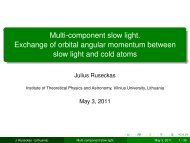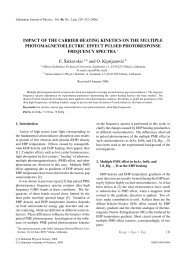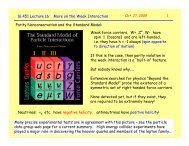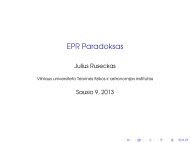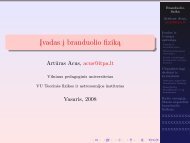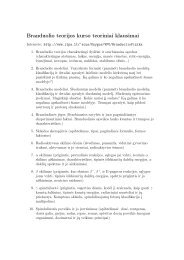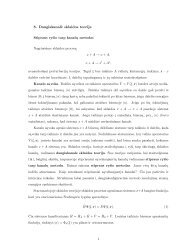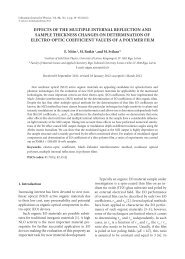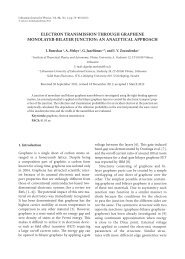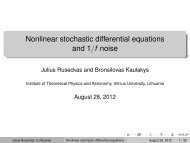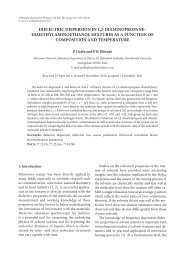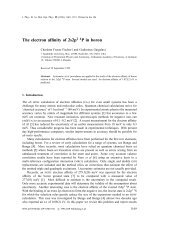BARRIER LAYERS IN CdSexS1-x FILMS FORMED BY SCREEN ...
BARRIER LAYERS IN CdSexS1-x FILMS FORMED BY SCREEN ...
BARRIER LAYERS IN CdSexS1-x FILMS FORMED BY SCREEN ...
You also want an ePaper? Increase the reach of your titles
YUMPU automatically turns print PDFs into web optimized ePapers that Google loves.
Lithuanian Journal of Physics, Vol. 52, No. 3, pp. 219–223 (2012)<br />
© Lietuvos mokslų akademija, 2012<br />
PHYSICOCHEMICAL FEATURES OF DIELECTRICAL NANO-<br />
<strong>BARRIER</strong> <strong>LAYERS</strong> <strong>IN</strong> CdSe x<br />
S 1-x<br />
<strong>FILMS</strong> <strong>FORMED</strong> <strong>BY</strong> <strong>SCREEN</strong><br />
PR<strong>IN</strong>T<strong>IN</strong>G METHOD<br />
Yu.V. Trofimov a , L.N. Survilo a , E.F. Ostretsov a , and M.S. Tivanov b<br />
a<br />
SE Center of LED and Optoelectronic Technologies of National Academy of Sciences of Belarus, Logoiski trakt 22, 220090<br />
Minsk, Belarus<br />
b<br />
Belarusian State University, Nezavisimosty pr. 4, 220030 Minsk, Belarus<br />
E-mail: senso@inel.bas-net.by<br />
Received 29 August 2012; revised 27 March 2012; accepted 20 September 2012<br />
The thermal activation process of CdSe x<br />
S 1-x<br />
films, formed by screen printing, was investigated. We mostly<br />
focused on the influence of thermal treatment conditions on oxidised film formation on the crystalline grain<br />
surface with nano-barrier “dielectric-semiconductor” layer generation. The composition and thickness of nanobarrier<br />
layers were determined by X-ray diffraction (XRD) and X-ray photoelectron spectroscopy (XPS) methods.<br />
The thickness of nano-barrier layers was found to be 2–5 monolayers. It was shown that photoelectric properties<br />
of CdSe x<br />
S 1-x<br />
films were determined by the doping level and nano-barrier layer characteristics. By the use of<br />
XRD and SEM methods we experimentally investigated and justified that better microstructure and photoelectric<br />
properties (R D<br />
/ R L<br />
≥ 10 7 ) of CdSe x<br />
S 1-x<br />
films are achieved by photosensitivity activation during 15–30 min thermal<br />
treatment in quasi-closed air atmosphere at 550 °С or during 5–15 min at 600 °С with low speed cooling<br />
(3 °С/min). The manufacturing method for obtaining CdSe x<br />
S 1-x<br />
films with assigned characteristics determined by<br />
paste composition and properties, thermal treatment regime and medium optimisation was developed.<br />
Keywords: nano-barrier layer, thermal activation, screen printing, CdSe x<br />
S 1-x<br />
solid solution<br />
PACS: 78.55.Et, 85.30.Hi, 85.60.Dw<br />
1. Introduction<br />
It is well known that CdSe x<br />
S 1-x<br />
can be screen printed<br />
and sintered to form films that display photosensitivity.<br />
Such films are used to produce large-area<br />
photosensitive devices, commutating elements and<br />
more recently for photovoltaic cells [1, 2].<br />
Under development of CdSe x<br />
S 1-x<br />
film formation<br />
by using screen printing, the most important<br />
question is the investigation of nano-barrier “dielectric-semiconductor”<br />
layer generation [3] which<br />
is responsible for the photosensitivity of these materials.<br />
The parameters of this barrier can be manipulated<br />
by the processing temperature range, gas<br />
medium composition and paste formulation.<br />
2. Experiment<br />
The CdSe x<br />
S 1-x<br />
solid solution film formation was carried<br />
out in two ways. The first method consisted in<br />
preliminary synthesis of solid solution by means of<br />
original powders (CdS, CdSe), flux (CdCl 2 · H 2<br />
O),<br />
and dopant (CuОCl) mixture sintering. Then the<br />
ingot was crushed to particle size of
220<br />
Yu.V. Trofimov et al. / Lith. J. Phys. 52, 219–223 (2012)<br />
using the X-Pawer program and PDF-2 File. The<br />
surface morphology of the studied films was investigated<br />
with the scanning electron microscope<br />
LEO SUPRA 50 VP and Jeol JSM 6490LV. Atomic<br />
force microscopy (AFM) studies of grain boundaries<br />
were carried out with a scanning probe microscope<br />
(R47 Smena). XPS patterns were collected on<br />
the ESCALAB MK-II spectrometer equipped with<br />
a dual Al/Mg anode as a source of X-ray radiation.<br />
The anode was operated at 240 W (12 kV, 20 mA).<br />
On the base of these films photoresistors with<br />
indium contact metallisation were manufactured.<br />
The resistance of photoresistors was measured at<br />
200 lux illumination of a tungsten incandenscent<br />
lamp (light resistance R L<br />
) and without illumination<br />
(dark resistance R D<br />
). When the resistance change<br />
factor K R<br />
= R D<br />
/ R L<br />
, the ratio of dark resistance to<br />
light resistance was estimated.<br />
3. Results and discussion<br />
Thermal activation is the key process in photosensitive<br />
CdSe x<br />
S 1-x<br />
film producing. At this stage it is<br />
possible to achieve the necessary degree of photosensitivity<br />
and regulate many photoelectric properties<br />
and film structure. In the thermal activation<br />
process along with recrystallisation, the oxidation<br />
of film crystallites with the formation of the “dielectric-semiconductor”<br />
barrier takes place.<br />
Cadmium sulphide and/or selenide oxidation<br />
proceeds as follows:<br />
CdS + 2O 2<br />
= CdSO 4<br />
(550–650 °С), (1)<br />
2CdSе + 3O 2<br />
= 2CdSеO 3<br />
(410–650 °С). (2)<br />
Cadmium sulphate and/or selenite decomposition<br />
is carried out as follows:<br />
Fig. 1. X-ray diffractograms of СdS films thermally<br />
treated at different regimes: (1) in air; (2) and (3) in quasi-closed<br />
air atmosphere.<br />
The thermal treatment in nitrogen atmosphere<br />
allows producing films with good microstructure<br />
and without impurity phases still not having photoconductivity.<br />
Under thermal treatment in quasi-closed air atmosphere<br />
the sintered samples were laid in a stack<br />
with 0.5 mm gaps between them at the angle of<br />
60° in a closed titanium container. In this case the<br />
growth of grain took much more time which provided<br />
the formation of large grains with the size up<br />
to 10 μm (or even more). The reason of this was the<br />
control of CdCl 2<br />
evaporation rate, which defined<br />
the effective period of the eutectic melt steadystate.<br />
This enabled to decrease film imperfection<br />
due to better grain packaging (Fig.2). The dosed<br />
air oxygen exposure facilitates grain binding and<br />
enlargement with simultaneous film structural improvement.<br />
In case of quasi-closed volume during<br />
photosensitivity thermal activation the equilibrium<br />
between cadmium sulphite, cadmium oxide and<br />
2CdSO 4<br />
= 2CdO + 2SO 2<br />
↑+ O 2<br />
↑ (650–880 °С), (3)<br />
CdSеO 3<br />
= CdO + SеO 2<br />
↑ (650–720 °С). (4)<br />
The investigation of photosensitivity thermal<br />
activation atmosphere influence on phase composition,<br />
microstructure and photoelectric properties<br />
of films was carried out. The thermal treatment of<br />
films in air atmosphere resulted in full oxidation of<br />
film surface since the oxidation processes proceeded<br />
strongly at temperatures ≥500 °C (Fig. 1, curve 1).<br />
Fig. 2. SEM micrographs showing the surface morphology<br />
of films thermally treated in quasi-closed air atmosphere<br />
with low speed cooling (3 °С/min): (a) CdS 0.2<br />
Se 0.8<br />
:<br />
30 min / 550 °С, (b) CdS 0.8<br />
Se 0.2<br />
: 15 min / 600 °С.
221<br />
Yu.V. Trofimov et al. / Lith. J. Phys. 52, 219–223 (2012)<br />
sulphur oxide was established; therefore, cadmium<br />
sulphite was oxidised to cadmium sulphate, which<br />
is more stable at temperatures of photosensitivity<br />
thermal activation. This is confirmed by XRD<br />
(Fig. 1, curves 2 and 3).<br />
Figure 3 shows AFM images of the grain<br />
boundaries structure in CdS 0.8<br />
Se 0.2<br />
film (Fig. 2b)<br />
in greater detail. It is obvious that the depth of<br />
boundaries is not more than 150 nm. Thus at thermal<br />
activation in quasi-closed volume single-phase<br />
CdS 0.8<br />
Se 0.2<br />
films with the close-packed grain structure<br />
and well-formed grain boundaries were obtained.<br />
XPS data indicates the presence of the oxidised<br />
phase on grain surface. Cd 3d spectra are not in-<br />
formative, because Cd 3d 5/2<br />
line positions are<br />
slightly distinguished for different possible oxidation<br />
products containing Сd 2+ (CdSO 4<br />
, CdSeO 3<br />
,<br />
CdCO 3<br />
, CdS, CdSe and others). Therefore in this<br />
work the conclusions about CdS 1-x<br />
Se x<br />
film surface<br />
oxidation products are drawn on the base of S and<br />
Se spectra. In S 2p spectra two components with<br />
chemical shifts corresponding to typical cadmium<br />
sulphate and sulfide values are found (Fig. 4a).<br />
Moreover, in Se 3d spectra two components with<br />
chemical shifts corresponding to typical cadmium<br />
selenide and selenite values are found (Fig. 4b).<br />
To estimate the thickness of the oxidised layer on<br />
CdS film surface S 2p spectra with different excitation<br />
energies (1030, 485 and 205 eV) were recorded.<br />
Fig. 3. AFM images of the grain boundaries structure in CdS 0.8<br />
Se 0.2<br />
.<br />
Fig. 4. S 2p and Se 3d XPS spectra of CdS 0.2<br />
Se 0.8<br />
film.
222<br />
Yu.V. Trofimov et al. / Lith. J. Phys. 52, 219–223 (2012)<br />
As it is seen from Fig. 5, relative intensity of<br />
S II (S 2<br />
2–<br />
), S III (S 0 ) and S IV(SO 4<br />
2–<br />
) components<br />
in S 2p spectra is decreased with excitation energy<br />
increasing, i. e. surface atom contribution to the<br />
registered signal is decreased. The dependence of<br />
excitation energy on the escape depth of electrons<br />
is given in Table 1 (data are calculated using TTP-<br />
2m program [7]).<br />
Table 1. The escape depth of S 2p electrons for different<br />
excitation energies.<br />
No. Excitation energy (Е), eV Escape depth (λ), Å<br />
1 205 4.51<br />
2 485 9.89<br />
3 1030 18.23<br />
These results mean that all listed components<br />
are related to the CdS surface layer. The thickness<br />
of this layer is estimated to be ~5–10 Å. Hence, only<br />
2–5 monolayers are formed on the CdS surface<br />
during thermal treatment of CdSe x<br />
S 1-x<br />
films in the<br />
regime of quasi-closed air atmosphere.<br />
Thus CdSO 4<br />
, CdSeO 3<br />
and CdO are basic oxidation<br />
products. With the film photosensitivity thermal<br />
activation continuation the amount of oxidised<br />
components corresponding to SO 4<br />
2–<br />
SeO 3<br />
2–<br />
is increasing.<br />
The better photoelectric properties (R D<br />
/ R L<br />
≥ 10 7 )<br />
of photoresistors, based on CdSe x<br />
S 1-x<br />
films, are<br />
achieved by photosensitivity activation during<br />
15–30 min thermal treatment in quasi-closed air<br />
atmosphere at 550 °С or during 5–15 min at 600 °С<br />
with low speed cooling (3 °С/min).<br />
4. Conclusion<br />
The physico-technological aspects of controllable<br />
nano-barrier “dielectric-semiconductor” layer formation<br />
are developed. This enables to produce well<br />
crystallised films with high uniformity of photoelectric<br />
properties on the whole substrate. The thickness<br />
of this nano-barrier consisting of CdSеO 3<br />
,<br />
CdSO 4<br />
and CdO amounts to 2–5 monolayers.<br />
On the base of these films we produced photoresistors<br />
with low light resistivity (R L<br />
< 50 Ohm) and<br />
high R D<br />
/R L<br />
ratio (≥10 7 ).<br />
Acknowledgements<br />
Fig. 5. S 2p spectra of CdS film with different excitation<br />
energies: (a) 1030 eV; (b) 484 eV; (c) 205 eV.<br />
The authors would like to thank L. Yashina and<br />
D. Strateychuk (Moscow State University) for assistance<br />
and result interpretation in X-ray diffraction,<br />
XPS and AFM studies.
223<br />
Yu.V. Trofimov et al. / Lith. J. Phys. 52, 219–223 (2012)<br />
References<br />
1. J.N. Ross, Thick-film photosensors, Meas. Sci.<br />
Technol. 6(4), 405–409 (1995).<br />
2. S. Ikegami, CdS/CdTe solar cells by the screenprinting-sintering<br />
technique: fabrication, photovoltaic<br />
properties and applications, Solar Cells<br />
23(1–2), 89–105 (1988).<br />
3. R.H. Bube, Photoelectronic Properties of<br />
Semiconductors (Cambridge University Press,<br />
Cambridge, 1992).<br />
4. M. Tivanov, E. Ostretsov, N. Drozdov, L. Survilo,<br />
A. Fedotov, Yu. Trofimov, and A. Mazanik, Optical<br />
and photoelectrical properties of CdS x<br />
Se 1–x<br />
films<br />
produced by screen-printing technology, Phys.<br />
Status Solidi B 244(5), 1694–1699 (2007).<br />
5. D.M. Strateichuk, E.F. Ostretsov, V.I. Shtanov,<br />
L.N. Survilo, Yu.V. Trofimov, I.A. Ryzhikov, and<br />
R.Kh. Akchurin, Effects of paste composition and<br />
heat-treatment conditions on the microstructure<br />
of polycrystalline CdS 1-x<br />
Se x<br />
films, Inorg. Mater.<br />
44(1), 6–12 (2008).<br />
6. A.S. Meshkov, E.F. Ostretsov, W.V. Pogosov,<br />
I.A. Ryzhikov, and Yu.V. Trofimov,<br />
Photoconductivity of CdS-CdSe granular films: influence<br />
of microstructure, Semicond. Sci. Technol.<br />
25, 065013 (2010), doi:10.1088/0268-1242/25/6/<br />
065013.<br />
7. QUASES-IMFP-TPP2M, www.quases.com.<br />
STORASLUOKSNE TECHNOLOGIJA PAGAM<strong>IN</strong>TŲ CdSe x<br />
S 1-x<br />
SLUOKSNIŲ FIZ<strong>IN</strong>ĖS<br />
IR CHEM<strong>IN</strong>ĖS DIELEKTR<strong>IN</strong>IŲ NANOBARJERŲ SAVYBĖS<br />
Yu. V. Trofimov a , L. N. Survilo a , E. F. Ostretsov a , M. S. Tivanov b<br />
a<br />
VĮ „Baltarusijos nacionalinės mokslų akademijos šviestukų ir optoelektroninių technologijų centras“, Minskas, Baltarusija<br />
b<br />
Baltarusijos valstybinis universitetas, Minskas, Baltarusija<br />
Santrauka<br />
Ištirta CdSe x<br />
S 1-x<br />
sluoksnių, pagamintų storasluoksne<br />
technologija, termoaktyvacinio proceso eiga.<br />
Pagrindinis dėmesys skirtas terminių sąlygų įtakai formuotis<br />
oksiduotiems ploniesiems sluoksniams kristalo<br />
paviršiuje vykstant nanobarjero sluoksnio „dielektrikas–puslaidininkis“<br />
generavimui. Nanobarjero sudėtis<br />
ir storis (2–5 monosluoksniai) nustatyti Rentgeno<br />
difrakcijos ir Rentgeno fotoelektronų spektroskopijos<br />
(XPS) metodais. Parodyta, kad fotoelektrines plonųjų<br />
CdSe x<br />
S 1-x<br />
sluoksnių savybes lemia priemaišų įtaka ir nanobarjero<br />
sluoksnio parametrai. XRD ir skenuojančios<br />
elektroninės mikroskopijos metodais eksperimentiškai<br />
nustatyta, kad geriausia mikrosandara ir fotoelektrinės<br />
savybės (R D<br />
/R L<br />
≥ 10 7 ) gaunamos fotojautrio aktyvacijos<br />
metu termiškai veikiant 15–30 min kvazi-uždaroje oro<br />
atmosferoje 550 °C temperatūroje arba lėtai šaldant<br />
(3 °C/min) 5–15 min 600 °C temperatūroje. Sukurtas<br />
plonųjų CdSe x<br />
S 1-x<br />
sluoksnių, pasižyminčių tam tikromis<br />
savybėmis, gamybos metodas. Šias sluoksnių savybes lemia<br />
pastos sudėtis ir savybės, terminė proceso eiga bei<br />
aplinkos sąlygų optimizavimas.



